This is a Veteran Owned site
![]()
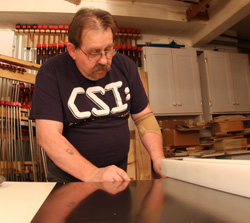 |
Does it look like I am doing anything wrong here as I set my fence? I am and the fence setting is out by around 1/8" even though I have the cursor over the scale line I want. Parallax is the issue and I am the problem, sort of. Click image to enlarge |
Parallax
What it is and what it ain’t
Text, photos and video by Tom Hintz
Posted – 8-8-2011
Not long ago I answered a question on a forum, suggesting to the original poster that his difficulty in setting his fence correctly might be caused at least in part to parallax. Almost immediately I received an email from one of that forums self-appointed “experts” that informed me that I was totally wrong. He "knows" that parallax is a medical condition where one of the eyes grows tired after looking at one thing too long. (For all of the medical folks who just jumped up, I know) I started to type a reply to his email but then realized how futile that would be. That exchange did inspire this story, one that I have been meaning to do for a long time but kept forgetting which brings up a whole different issue that we need not investigate here.
What It Is
Parallax is a trick of the combination of distance and angle that causes a sort of illusion that makes you think the alignment of two marks is correct when in fact they are not. Nobody is immune to parallax because it has nothing to do with the quality of a person’s vision. If you can see you can experience parallax. Leigh Jigs has been aware of parallax from the beginning and is concerned enough to include an illustrated warning about it in their superb User Guides that are included with their dovetail jigs and other tools.
The point of this story is to show you what parallax is and how to avoid it. Once you see how parallax occurs avoiding it is easy. OK easy for most people. The “expert” mentioned above might continue to have issues when one of his eyes poops out.
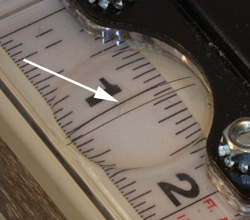 |
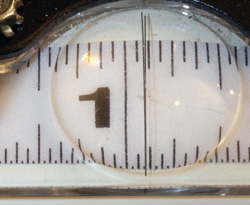 |
Looking from and angle (left) the cursor lines appear aligned with the 1" mark. However, get the camera directly over the 1" mark and we can see there is a major error. Click images to enlarge |
|
For parallax to occur we need three things – your eyes, a target mark and a cursor that is some distance (often very little) above the target mark. Things like a table saw fence and dovetail jig cursors may be the most common tools on which to experience parallax but this can happen on ay machine or tool that uses a scale and cursor. For our purposes here I will focus primarily on the table saw because that is probably the tool that is most common to the largest number of woodworkers.
How It Happens
If you are looking straight down on your fence cursor you can accurately align the cursor’s line and the desired line on the fence scale. However, if you try to align the cursor and scale lines from either side the effects of parallax cause an error.
When you look at the cursor line from the side its height above the scale causes the parallax. We need to move the fence (and cursor) to the same side of the scale mark that we are looking at it from to get those marks to align. Then if we go back and look at the scale from directly above we can see the amount of parallax error. I have walked people through this exercise and they will stop dead when they go back directly over the mark because they can’t believe it is so far off. But it is and neither of their eyes is tired!
Some cursors have a magnifying lens built into them that has lines etched on the top and bottom surfaces. When you look at this from the side it is very confusing. I’m not sure if that was the goal for having two lines or not but it should be a warning if you see what looks like two lines instead of one. I have tried these two-line cursors with the curved side up and down and neither eliminates parallax though with the curved side down it did drag ont he fence rail on one saw so I don't put it in that way anymore.
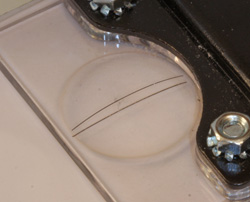 |
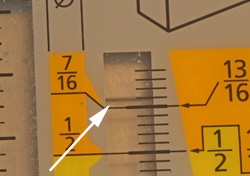 |
Here is the table saw cursor (left) with a piece of paper beneath it. Now yo can see the double line more clearly when viewed from the side. I don't think that this is an accident. If I look at the scale on my Leigh jig at an angle, (right) this time front to back, the same type of error is forced by parallax. Click images to enlarge |
|
Parallax is not exclusive to side angles, it occurs anytime you look at a scale from any angle. On my Leigh D4R dovetail jig the scales run front to back. If I do not put my head directly over the scale parallax will “build in” a small but frustrating amount of error that can compromise the fit of dovetails. Front-to-back or side-to-side or anything in between, if you look at a scale from an angle parallax is a certainty.
Avoiding Parallax
The good news in all this is parallax is very easy to avoid. All we have to do is remember to look at the scales and cursors from directly over the part of the scale we are using. The same applies to wall-mounted scales like on panel saws. If you look at the portion of the scale being used straight on, parallax is eliminated. Look at the vertical scales from above or below and there will be a parallax error.
Woodpeckers began manufacturing a line of CNC machined rulers that feature a tapered edge where the numerals and has marks are. That angle is there to bring the lines of the scale as close to the surface as possible to reduce the chances of parallax. With the marks so close to the surface it is easier to make a layout mark right at the correct scale line. Both of those qualities make using the Woodpeckers rules with this tapered edge way easier if you want to be accurate.
Conclusion
Video Tutor |
Maybe the hardest part of avoiding parallax is remembering to put our heads directly over the scale to avoid it. There are no audible alarms that warn that you are out of position to make a setting correctly. Other people within earshot might get the message from the string of ugly words you utter when you discover that you just cut an important part a little too small because of the parallax factor.
I have been doing this for over 40 years now and I still catch myself setting a fence or jig from the side once in a while. Usually I am only a little to the side but it frustrates me because I know that a small error is still an error that I already know how to eliminate.
Have a comment on this story? Email Me!
All written, photographic and drawn materials are property of and copyright by NewWoodworker.com LLC 2000-2019. Materials may not be used in any way without the written permission of the owner.
